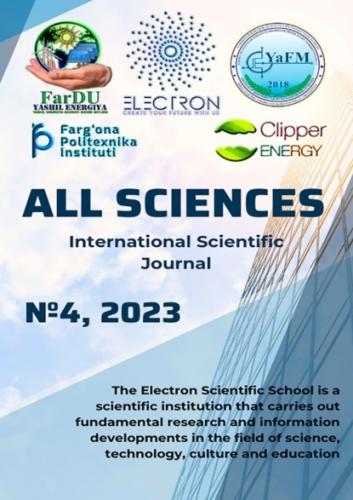International Scientific Journal
Authors: Aliyev Ibratjon Xatamovich, Karimov Boxodir Xoshimovich, Karimov Shavkat Boxodirovich, Usmonov Yakub Usmonovich, Axmedov Tursun Axmedovich, Yuldoshaliyev Dilshod Quldoshaliyevich, Sayitov Shavkat Samiddinovich, Xolmatov Erkinjon Soliyevich, Obidov Foziljon Oripovich, Abdusalyamova Tilloxon, Karimova Dilorom Shavkatovna, Tulyaganov Abdumannop Abdujabbarovich, Baratov Mirodiljon Xamudjanovich, Begatov Jasurbek, Qo'shqorov Ahliddin Mirzoxidovich, Raxmonjonov Xasanboy, To'xtasinov Maqsadjon Murodjonovich
Editor-in-Chief Ibratjon Xatamovich Aliyev
Illustrator Ibratjon Xatamovich Aliyev
Illustrator Obbozjon Xokimovich Qo'ldashov
Illustrator Sultonali Mukaramovich Abduraxmonov
Illustrator Boxodir Xoshimovich Karimov
Cover Designer Ibratjon Xatamovich Aliyev
Cover Designer Ra'noxon Mukaramovna Aliyeva
Cover Designer Boxodir Xoshimovich Karimov
Scientific supervisor Boxodir Xoshimovich Karimov
Deputy Scientific Director Sultonali Mukaramovich Abduraxmonov
Economic Manager Farruh Murodjonovich Sharofutdinov
Economic Consultant Botirali Rustamovich Jalolov
Proofreader Gulnoza Muxtarovna Sobirova
Proofreader Abdurasul Abdusoliyevich Ergashev
Proofreader Ekaterina Aleksandrovna Vavilova
© Ibratjon Xatamovich Aliyev, 2023
© Boxodir Xoshimovich Karimov, 2023
© Shavkat Boxodirovich Karimov, 2023
© Yakub Usmonovich Usmonov, 2023
© Tursun Axmedovich Axmedov, 2023
© Dilshod Quldoshaliyevich Yuldoshaliyev, 2023
© Shavkat Samiddinovich Sayitov, 2023
© Erkinjon Soliyevich Xolmatov, 2023
© Foziljon Oripovich Obidov, 2023
© Tilloxon Abdusalyamova, 2023
© Dilorom Shavkatovna Karimova, 2023
© Abdumannop Abdujabbarovich Tulyaganov, 2023
© Mirodiljon Xamudjanovich Baratov, 2023
© Jasurbek Begatov, 2023
© Ahliddin Mirzoxidovich Qo'shqorov, 2023
© Xasanboy Raxmonjonov, 2023
© Maqsadjon Murodjonovich To'xtasinov, 2023
ISBN 978-5-0060-3821-9 (т. 4)
ISBN 978-5-0059-5900-3
Created with Ridero smart publishing system
PHYSICAL AND MATHEMATICAL SCIENCES
OPTICAL AND SOUND MEMORY IN LITHIUM NIOBATE CRYSTALS
UDC 535.215.31
Karimov Boxodir Xoshimovich
Candidate of Physical and Mathematical Sciences, Associate Professor of the Faculty of Physics and Technology of Fergana State University
Karimov Shavkat Bakhodirovich
Candidate of the Faculty of Physics and Technology of Fergana State University
Aliev Ibratjon Xatamovich
3rd year student of the Faculty of Mathematics and Computer Science of Fergana State University
Ferghana State University, Ferghana, Uzbekistan
Annotation. PHOTOEDC (or photovoltage) in semiconductors, regardless of its nature, cannot exceed the band gap width, i.e. several volts/cm.
Keywords: PHOTOEDC, photovoltaic current, crystals without a center of symmetry, semiconductors, third-rank tensors, Fermi-level energies.
Аннотация. Фото-ЭДС (или фотонапряжение) в полупроводниках независимо от ее природы не может превышать ширину запрещенной зоны, т.е. несколько Вольт/см.
Ключевые слова: фото-ЭДС, фотовольтаический ток, кристаллы без центра симметрии, полупроводники, тензоры третьего ранга, энергии уровня Ферми.
For example, in a homogeneous semiconductor, the Dember (diffusion) photo voltage for an arbitrarily high intensity of exciting light does not exceed the value [1].
(1)
where Eg is the band gap of the semiconductor, n1 and n0 are, respectively, nonequilibrium and equilibrium carrier concentrations, Nc is the density of states.
Another example is the resulting photovoltage during illumination of the p-n junction [2].
(2)
which also does not exceed Eg. Here nn and pp are, respectively, electron concentrations in the n—region and holes in the p—region. EFn and EFp are Fermi—level energies in the n— and p-regions.
The exception to this rule was only semiconductor textures in which the effect of abnormally high photo voltages (AFN effect) is observed, due to the addition of elementary photo-EMF of the Dember (1) or elementary photo-EMF (2), developing at individual p-n transitions of the texture [3].
In such textures from sprayed layers of CdTe, Ge, Si, GaAs, PbS, CdSe, etc., photo voltages can reach values of the order of several hundred Volts per centimeter of length in the direction of addition of elementary photo-EMF (1) or (2).
In recent years it has become clear that currents are possible in thermodynamic nonequilibrium conditions of a different nature, due to the absence of a center of symmetry environment. The most important of this class of effect is the anomalous photovoltaic effect (AF effect).
The AF effect is that with uniform illumination of a short-circuited ferroelectric, a stationary current flows through it, which in [4,5] was called photovoltaic. It has been shown that it is the photovoltaic current that leads to the anomalous photovoltaic effect (AF effect) in ferroelectrics.
The anomalous photovoltaic effect detected for ferroelectrics for the first time in [4,5] is a special case of the AF effect described for crystals without a center of symmetry by the third rank aijk tensor [5,6]:
(3)
According to (3), with uniform illumination by linearly polarized light of homogeneous crystals without a center of symmetry (ferroelectric, pyro, or piezoelectric crystal), a photovoltaic current Ji arises in it, the sign and magnitude of which depend on the orientation of the polarization vector of light with projections EJ, EK*.
The components of the aijk tensor are nonzero for 20 acentric symmetry groups. If the electrodes of the crystal are opened, the photovoltaic current Ji generates photovoltaic voltages
where σt and σf, respectively, are dark and photoconductivity, l is the distance between the electrodes. Generated photovoltage in crystals without a center of symmetry of the order (103—105). In/see In accordance with (3) and the symmetry of the point group of the crystal, expressions can be written for the photovoltaic current Ji. Comparison of the
